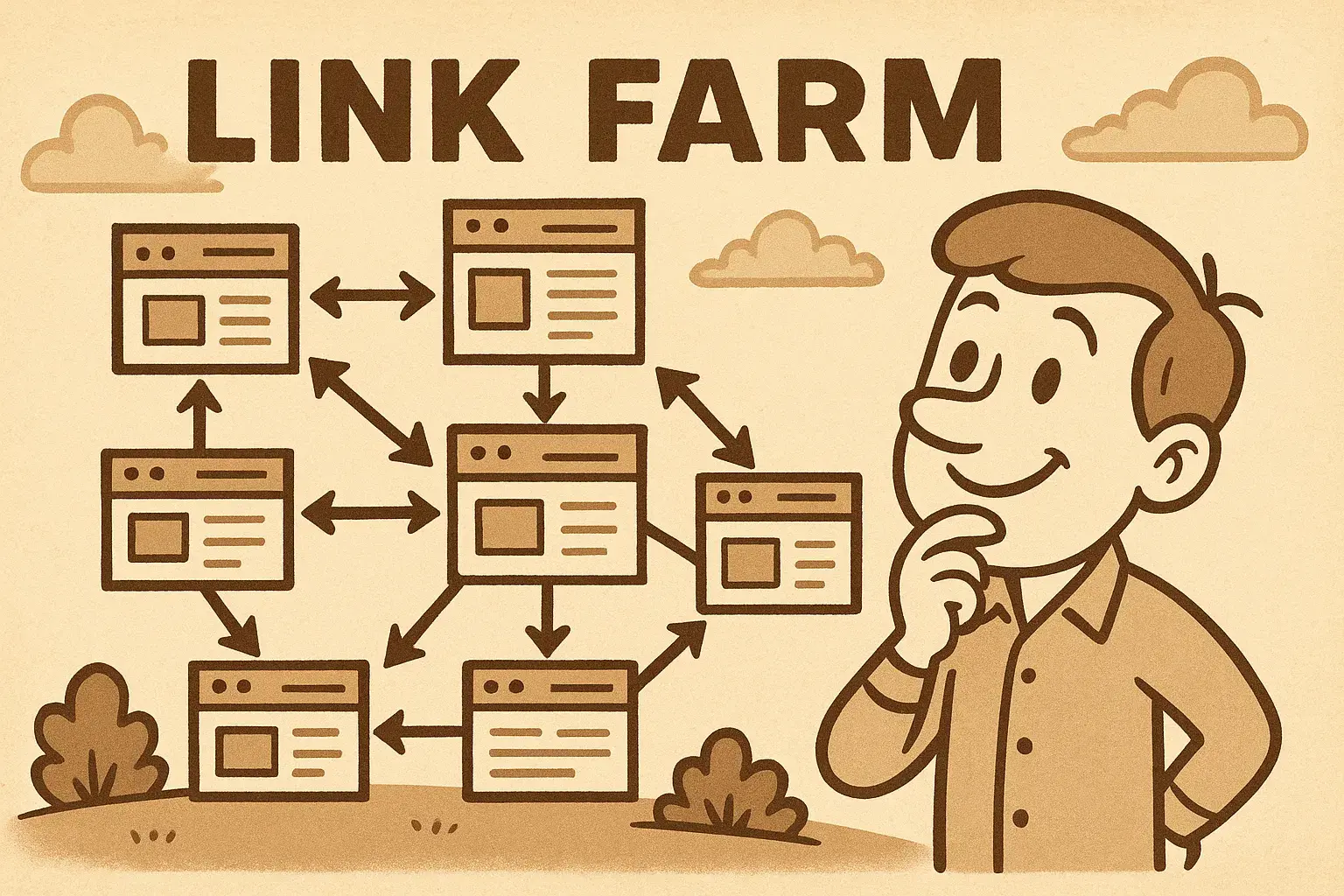Link Farms: What SEO Experts Need to Know Today

For years, link farms have been viewed as relics of a bygone SEO era, a tactic from the early 2000s that no one serious uses anymore. But in client audits and agency retrospectives, I’ve seen traces of them still operating, sometimes unintentionally. That’s the part that should make any SEO expert pause.
Search engines have evolved, and yet certain incentives remain stubbornly intact. The pressure to acquire backlinks at scale is one of them. Whether out of desperation, ignorance, or willful risk-taking, many websites still end up in link networks that toe the line between low-quality partnerships and full-blown link farming. In my experience, the line isn’t always clear.
What defines a link farm in today’s context?
Originally, link farms were straightforward: clusters of websites designed solely to exchange links and manipulate PageRank. But that definition doesn’t capture what we see today. Most modern link farms look nothing like the spammy directories of the past. They masquerade as blogs, media sites, or niche resource hubs, often with halfway decent UX and AI-generated content. The link schemes are buried deeper, camouflaged by attempts at editorial consistency.
If you’re reviewing a backlink profile and see hundreds of sites linking to each other, all with low traffic and virtually identical anchor text strategies, that’s a red flag. But not every network is a link farm. That’s where the nuance comes in. Some networks are built by agencies or outreach collectives that maintain editorial control. Others are hacked-together PBNs with recycled content and churn-and-burn hosting.
In my practice, I classify a group as a link farm when:
-
The sites share ownership or infrastructure
-
There’s no legitimate audience or engagement
-
The outbound linking pattern lacks editorial discretion
-
Multiple domains exist solely to serve links to one or more target sites
That last point is crucial. Intent still matters. You can have low-quality sites with authentic linking behaviors. But you can’t have good intentions and consistently unnatural linking patterns.
Why link farms still exist in 2025
Despite algorithm advances, there’s still a strong economic incentive to fake authority. According to The Backlink Company’s 2025 link building survey, over 40% of marketers said they struggle to get high-quality backlinks due to budget and time constraints. That makes scalable systems appealing, even when they’re risky.
Some site owners justify the use of link farms by treating them as a stopgap — a temporary ranking booster. They plan to disavow later, or assume they won’t get caught. But others are unaware. I’ve seen B2B SaaS companies unknowingly buy placements on farmed domains via shady link vendors who promise "niche relevant" posts.
And then there are hybrid networks — some sites in the group are legitimate, others are shells. These setups make it harder for tools to detect bad neighborhoods and harder for SEOs to draw clean lines between ethical and exploitative link building.
How to identify link farm links during audits
One of the more frustrating challenges in SEO audits is determining when you’re dealing with isolated spam versus systemic link farming. Here’s what I look for:
1. Anchor text homogeneity If 90% of anchor texts use exact match or near-match phrases, especially on different domains, that suggests coordination. Organic link profiles rarely behave that way.
2. Network clustering SEO tools like Ahrefs and Majestic allow you to map referring domains and IPs. If many backlinks come from the same hosting block or CDN, that’s a clustering signal.
3. Reused templates I’ve come across networks where 20+ sites use the same WordPress theme and structure. It’s not just lazy design — it’s a clue the sites are operated by the same entity.
4. Topic mismatch When a marketing SaaS product gets backlinks from unrelated sites like “Best Plumbing Services in Ohio” or “Top Dog Breeds in 2025,” that’s a contextual warning. Relevance is a proxy for editorial choice.
5. Poor link neighborhood hygiene Sites that link to known spam sites or gambling/crypto pages usually don’t maintain high editorial standards.
How link farms operate
Structure and mechanics
Link farms consist of a group of websites that interlink extensively, often without regard to content relevance or quality. The pages may appear to function independently, but they are typically controlled by the same person or agency. Many link farms are manually created, with someone publishing posts across a large domain portfolio. Others are spun up using automated scripts, AI-written content, and syndicated link blocks to reduce operational overhead.
Some operators use cheap expired domains that carry legacy metrics like high DA or existing backlinks. They then build thin sites around these domains to push link equity toward client pages. The process is streamlined, but the end result is rarely useful for readers or long-term SEO gains.
Common characteristics
Most link farms share several telltale qualities. First, the content tends to be low-quality or irrelevant. It is often AI-generated or repurposed with minor edits. Second, you’ll see a high number of outbound links, sometimes dozens on a single page, pointing to unrelated commercial targets. These links are typically hardcoded, not editorial.
Third, the sites usually have templated or very basic designs. You might find 10 different domains using the same WordPress theme with identical footers. Finally, there’s little to no original content. These sites don’t produce anything people actually want to read. They exist solely to manipulate link metrics.
Are link farms always a penalty risk?
Google’s public stance is clear: link schemes violate their guidelines. But in practice, not every link farm results in a manual penalty. Some get ignored. Others get discounted algorithmically. The biggest risk isn’t always getting penalized — it’s wasting budget on ineffective links.
In competitive niches, I’ve seen sites dominate short-term SERPs with aggressive link networks, only to crash six months later. And sometimes they recover by rebuilding cleaner profiles. The cycle isn’t sustainable, but it’s tempting for growth-hungry startups.
In my experience, the real SEO pros aren’t just trying to avoid penalties — they’re trying to build moats. That means earning links that not only rank, but also bring referral traffic, branding, and trust.
The gray zone: agency-built networks
One of the trickiest areas is agency-built site networks. These aren’t overt PBNs. They often include semi-legit blogs with original content, some social presence, and basic user engagement.
I’ve worked with clients who discovered that their link vendor operated dozens of these “owned media” sites. Technically, they weren’t link farms. But they lacked diversity and editorial independence.
When the same owner publishes all the content and decides which sites get links, it creates a soft link scheme — one that might not trigger manual action but still looks artificial in aggregate. In The Backlink Company’s client case studies, I saw examples where sites cleaned up these profiles and regained rankings not because of penalties, but because Google started trusting them more post-disavow.
Should SEOs disavow link farm backlinks?
There’s no universal answer. Google has said the disavow tool is unnecessary unless you’re facing a manual action. But I’ve seen cases where cleaning up low-quality links correlated with improved crawl activity and ranking stability.
The key is to avoid over-pruning. If you cut links from every low-traffic domain, you risk damaging your authority. I’ve found that disavowing entire domains is safer than disavowing individual URLs, especially when you spot systemic patterns.
When in doubt, ask: is this a link that would exist if SEO didn’t exist? If the answer is no, and the domain pattern matches what you’d call a link farm, it’s probably worth cleaning up.
How link farms affect niche SaaS SEO
In SaaS, link velocity often determines how fast you can rank for commercial queries. Many founders try to speed this up with link packs, bundled placements, or "guaranteed DR 50+" offers. That’s where link farms creep in.
I worked with a SaaS tool that had 800+ backlinks from finance blogs, all with nearly identical article formats and CTAs. The site ranked well initially, but traffic dropped once Google flagged those links as manipulative. We rebuilt the link profile with industry podcasts, comparison pages, and targeted guest posts. It took time, but rankings bounced back.
The mistake wasn’t using paid links — it was buying links from fake publications. SEO doesn’t punish intent as much as it punishes predictability. And link farms are predictable by design.
Common myths about link farms
Myth 1: They’re only used by black hat SEOs Plenty of white hat SEOs inadvertently land in link farm territory through outsourcing. Just because a vendor looks clean doesn’t mean the domains they use are.
Myth 2: You’ll always get penalized Many link farm links are simply devalued. They don’t help or hurt. But they waste budget and create noise in your analytics.
Myth 3: All PBNs are link farms Some private networks have editorial standards. The difference lies in quality, transparency, and intent. Not every owned network is manipulative.
Myth 4: Link farms are dead They’ve evolved. They hide behind AI content, DA metrics, and thematic design. But they still exist.
What I recommend instead
In practice, I’ve found success avoiding link farms by building small link partnerships with real brands. That means:
-
Interviewing peers in the niche
-
Trading resource mentions with SaaS tools we actually use
-
Publishing teardown-style content that earns organic links
It’s not scalable in the traditional sense, but it compounds. And the links hold up over time.
For clients, we vet all vendors by inspecting their domain portfolio, checking Wayback snapshots, and manually browsing the sites. If it feels farmy, we skip it. No amount of DR or DA is worth it.
Link farms aren’t going away. But they don’t have to be part of your strategy. If you’re doing SaaS link building and want help separating signal from noise, check out our services.

 By
By


